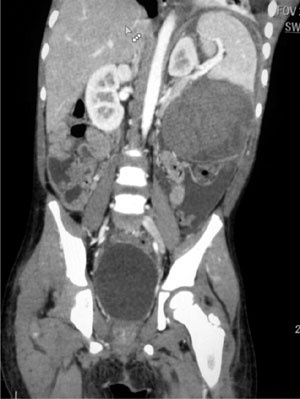|
|
|
Indian Pediatr 2016;53: 930 |
 |
Non-operative Management of Spontaneous
Splenic Rupture in Hemophilia
|
|
*Shyama Choudhary and
#Satyendra Khichar
*Department of Pediatrics and #Medicine,
Dr SN Medical College, Jodhpur, Rajasthan, India.
Email:
[email protected]
|
|
Historically, the treatment of splenic rupture has been splenectomy.
With the emergence of splenic conservation in splenic trauma, similar
concept has been applied to spontaneous rupture in other conditions.
There are only few case reports of isolated splenic rupture in patients
with hemophilia managed operatively with splenectomy [1,2]. Here, we
describe the successful non-surgical management of an isolated splenic
rupture in a child with severe hemophilia A.
A 6-year-old presented with breathlessness, colicky
left-sided loin pain followed by feeling of weakness and black stools.
There was no history of trauma. His examination revealed pallor,
tachypnea, tachycardia, hypotension, and tenderness and guarding to the
left hypochondrium. His hemoglobin level was 5.4 g/dL, activated partial
thromboplastin time was prolonged, and abdominal ultrasonography
revealed a hyperechogenic splenic mass. Patient was administered oxygen,
intravenous fluids and blood products in intensive care unit, resulting
in normalization of blood pressure and heart rate. Computed tomography
of abdomen showed large peripherally enhancing collection 117×76×85 mm
in lower pole of spleen with parenchymal thinning suggestive of splenic
rupture (Fig. 1). His factor VIII level was <1%. The
patient was managed conservatively with repeated blood product
transfusions and factor VIII concentrates (50 IU/kg/dose twice/day for
first three days), with monitoring of vitals. On day 14, abdominal
ultrasound showed reduction in size of hematoma and patient was
discharged.
 |
|
Fig. 1 CT scan abdomen showing large
peripherally enhancing collection (117×76×85) mm
seen in lower pole of spleen with internal debris (arrow)
communicate to peri-splenic collection with parenchyma thin out
up to 2.1 mm.
|
The standard criteria for non-operative management of
rupture spleen are hemodynamic stability/readily stabilizable; lack of
rebound and guarding; blood transfusions
³4 units; no lack of
consciousness; age <55 years; injury documented on imaging; and complete
recovery of bowel movements. The only absolute indi-cation for emergency
laparotomy is hemodynamic instability [3]. The benefits of non-operative
management are: low morbidity and mortality; preserved spleen; avoidance
of laparotomy; minimal blood transfusions; and decreased hospital stay
[3]. As our patient was young and hemodynamically stable, we opted for a
non-operative management (strict bed rest for 7-14 days, administration
of blood and blood products, serial monitoring of hemoglobin and vital
parameters). Several reports of successful non-operative management of
spontaneous and traumatic splenic bleeds in hemodynamically stable
patients have been described [4,5]. The intensive coagulation factor
replacement and correction of any other clotting abnormalities are the
cornerstones of a successful outcome. Splenic salvage should be the aim
in the management of these patients.
Acknowledgements: Dr Manish Parakh and Dr Pawan
Dara for providing inputs into manuscript writing.
Funding: None; Competing interest: None
stated.
References
1. Gedik E, Girgin S, Aldemir M, Keles C, Tuncer MC,
Aktas A. Non-traumatic splenic rupture: Report of seven cases and review
of the literature. World J Gastroenterol. 2008;14:6711-6.
2. Tengsupakul S, Sedrak A, Freed J, Martinez-Carde
L, Fireman F, Pierre L, et al. Splenic rupture in a newborn with
severe hemophilia – case report and review. J Pediatr Hematol Oncol. 2010;32:323-6.
3. Beuran M, Gheju I, Venter M, Marian R, Smarandache
R. Non-operative management of splenic trauma. J Med Life. 2012;5:47-58.
4. Sharma OP, Oswanski MF, Issa NM, Stein DT. Role of
non-operative management of spleen injury in patients with hemophilia:
Report of two patients with review of literature. J Emerg Med.
2011;41:e59-64.
5. Terry NE, Boswell WC. Nonoperative management of delayed splenic
rupture in a patient with hemophilia B. J Pediatr Surg. 2006;41:1607-9.
|
|
|
 |
|

